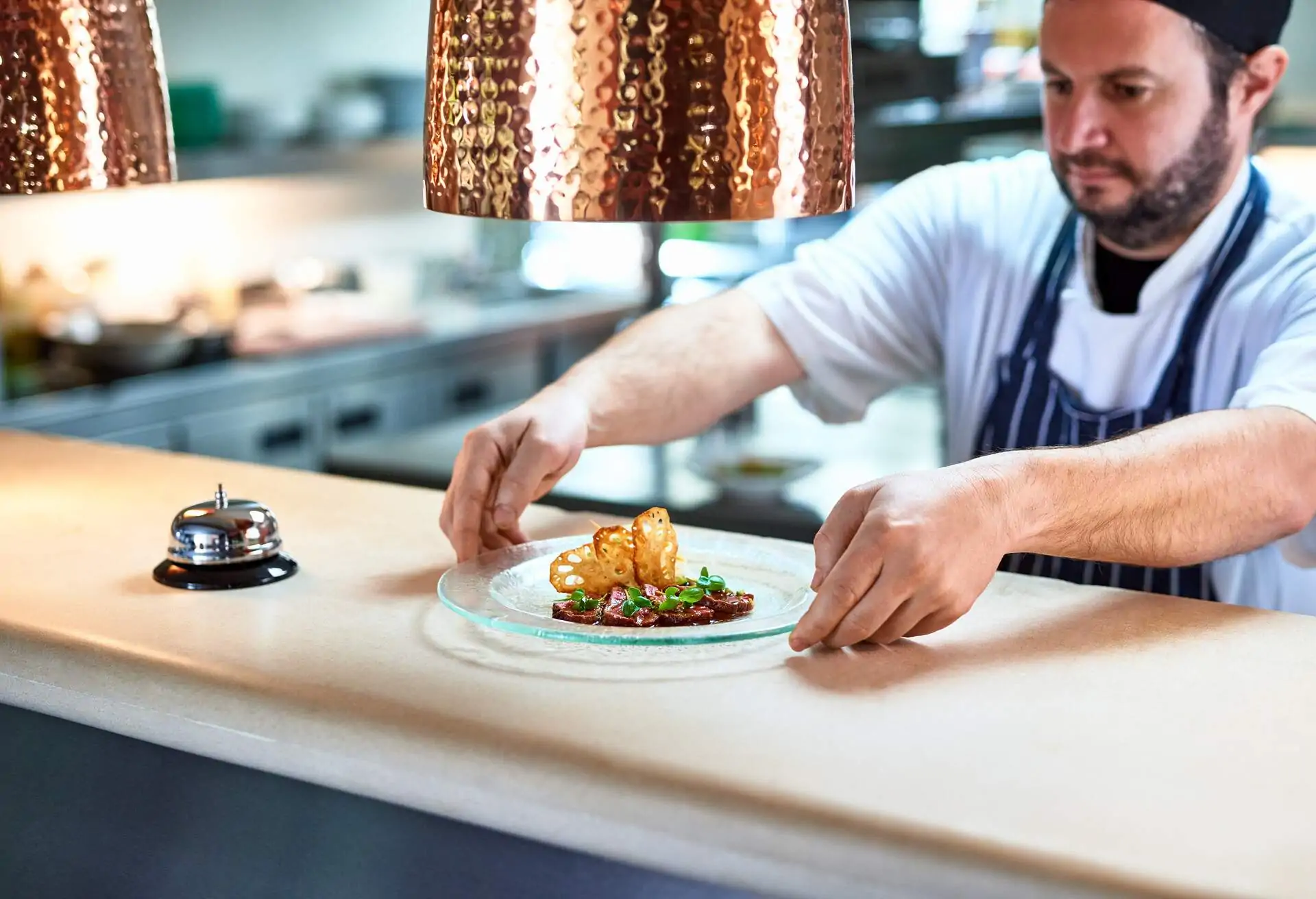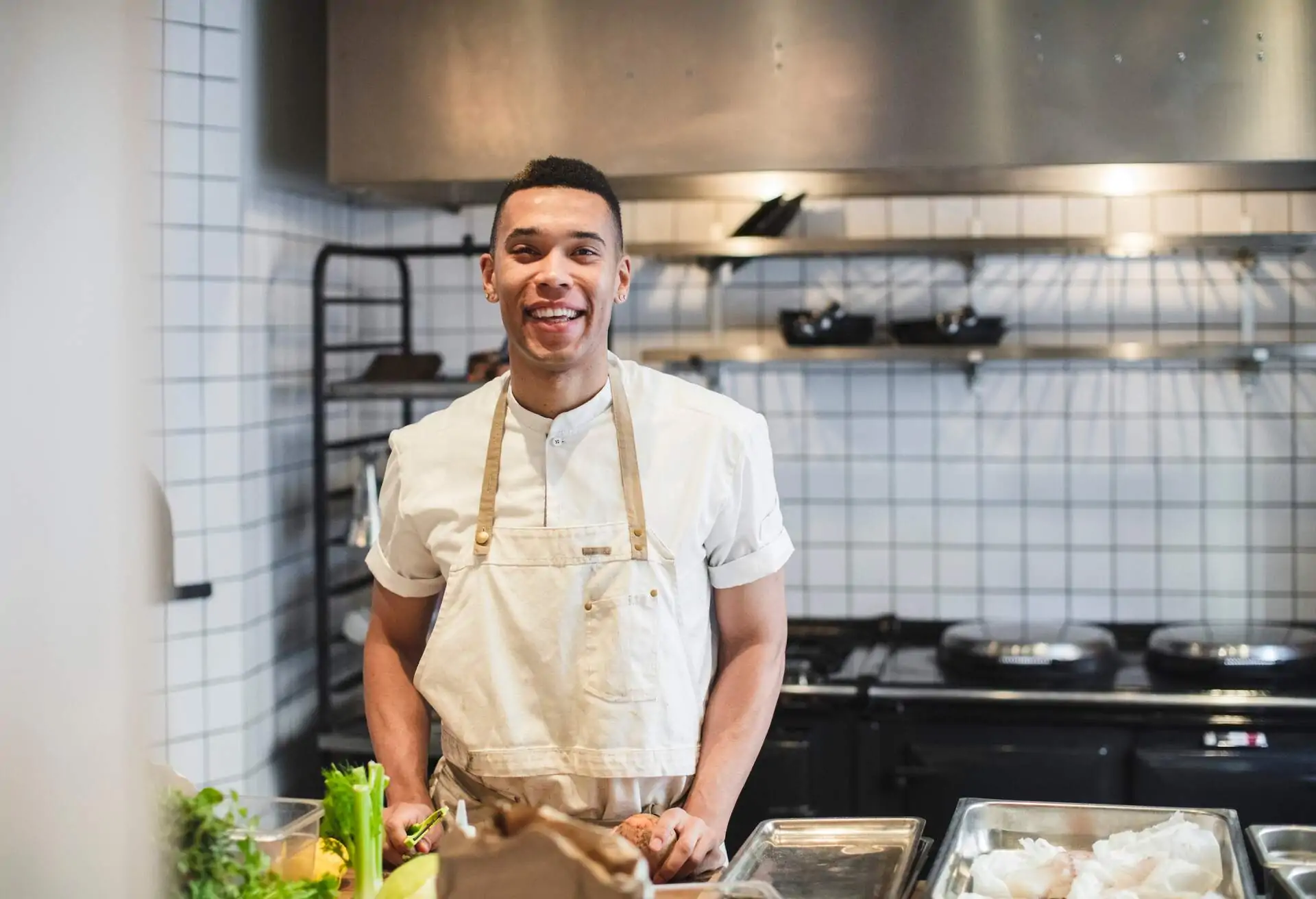While guests interact with the front of house staff, a whole team of skilled professionals work behind the scenes to bring the menu to life. These dedicated team members are back of house (BOH) and keep everything running smoothly, from prepping ingredients to washing dishes.
Let’s take a closer look at the various roles that make up a restaurant’s back-of-house team. Whether you’re curious about how restaurants operate or are considering a career in the industry, here’s an overview of what goes on behind those kitchen doors.
Executive chef
The executive chef is the mastermind of the kitchen. They create menus, manage the kitchen staff, and oversee food quality. You might even spot them representing the restaurant at events or in the media.
Executive chefs blend creativity with business acumen, balancing dish creation with cost management. All in all, an executive chef sets the tone for the entire kitchen, influencing everything from cooking techniques to plating styles.
Sous chef
Think of the sous chef as the executive chef’s right-hand person. They keep daily operations running smoothly and step in wherever needed, whether it’s menu planning or jumping on the line during busy services. Sous chefs often act as mentors to junior staff, passing on skills and maintaining kitchen standards. Their ability to bridge the gap between the executive chef’s vision and the practical realities of service is central to the restaurant’s success.
Chef de cuisine
In larger operations, the chef de cuisine runs a specific kitchen or restaurant within a larger establishment. They’re more hands-on with cooking than the executive chef but still maintain quality standards and training staff. Chefs de cuisine often have more freedom to experiment with daily specials and showcase their creativity while adhering to the overall direction set by the executive chef.
Line cook
Line cooks are the kitchen’s backbone. Quick, efficient, and cool under pressure, they prepare dishes at specific stations, keeping the quality consistent even when the heat is on. Line cooks might specialize in certain areas like grilling, sautéing, or frying, becoming experts in their particular domain. A line cook needs to have the ability to work cleanly and quickly under pressure to keep the kitchen moving during busy service times.
Grill cook
Masters of the flame, grill cooks need impeccable timing to serve up perfectly cooked steaks, burgers, fish, and vegetables. They thrive in the high-heat environment of a busy grill station. Grill cooks must have an innate sense of how different meats and vegetables react to heat, adjusting their techniques for each item. They’re also responsible for maintaining the grill so it’s clean and at the right temperature throughout service.
Sauté cook
Sauté cooks are the multitasking maestros of stovetop cooking. From pasta dishes to pan-seared meats, they juggle multiple pans with precision and speed. These cooks need to have excellent control over heat and timing, as many sautéed dishes cook quickly and can easily be overcooked. Their station is often one of the busiest in the kitchen and requires both skill and stamina.
Fry cook
Crispy, golden, and never greasy—that’s the goal of a skilled fry cook. They maintain oil temperatures and timing to perfection, all while prioritizing safety around hot oil. Fry cooks need to understand how different foods react in the fryer, adjusting temperatures and cooking times accordingly. They’re also responsible for maintaining the quality of the frying oil and knowing when it needs to be filtered or changed.
Pantry cook
Also known as garde manger, pantry cooks are the artists behind cold dishes. Their knife skills and eye for presentation shine in salads, appetizers, and sometimes even desserts. Pantry cooks often work with delicate ingredients that require careful handling and precise cutting. They need to be organized and efficient, as their station typically produces a high volume of dishes during service.
Prep cook
Prep cooks set the stage for a smooth guest service experience. Their behind-the-scenes work of chopping, portioning, and organizing keeps the kitchen running like clockwork during busy times. Prep cooks need to be fast and accurate, following recipes and prep lists so that everything is ready for service. Their work is integral to maintaining consistency and efficiency in the kitchen.

Pastry chef
The pastry chef brings dessert menus to life, often starting early so fresh baked goods are ready for service. Pastry chefs blend artistry with science—they understand both the visual appeal of desserts and the chemical reactions that make them work. Don’t be surprised if they’re also responsible for bread production in some restaurants.
Pastry cook
Working under the pastry chef, these skilled bakers turn out everything from delicate pastries to show-stopping cakes. Pastry cooks need steady hands for intricate decorations and a good sense of timing for perfectly baked goods. They often specialize in certain areas like bread baking, chocolate work, or sugar art.
Baker
Early risers with a passion for bread, bakers know the secrets of perfect dough. They fill the kitchen with the irresistible aroma of fresh-baked goods each morning. Bakers need to understand fermentation processes and how different ingredients affect dough structure. You’ll find them working with a variety of flours and techniques to produce everything from crusty baguettes to soft dinner rolls.
Butcher
In-house butchers break down whole animals or large cuts with precise accuracy. Their deep knowledge of anatomy and cuts of meat is important for quality and cost control. Butchers need to understand different aging techniques and how to maximize the use of each animal. They typically work closely with chefs to provide the exact cuts needed for various dishes.
Fishmonger
The seafood specialist of the kitchen, fishmongers keep the catch of the day fresh and perfectly prepared. From fileting to shucking, they handle it all. Fishmongers need to be experts in assessing the freshness of seafood and storing it properly. Along with these responsibilities, they often build relationships with local fishermen to source the best products.
Sauce chef (saucier)
In traditional kitchens, the saucier holds a place of honour. They’re the alchemists of flavour, creating the sauces that elevate dishes from good to extraordinary. Sauciers need a deep understanding of flavour profiles and how different ingredients interact. You might also find a sauce chef managing the production of stocks and reductions, which form the base of many sauces.
Rotisserie cook
Specialists in slow-cooked perfection, rotisserie cooks manage the spinning spits that produce succulent roasted meats. Patience and attention to detail are their hallmarks. A key part of their job is understanding how different cuts of meat react to long, slow cooking processes. A rotisserie cock may also be responsible for preparing marinades and rubs to enhance flavours.
Vegetable cook (entremetier)
Masters of sides and staples, entremetiers bring out the best in vegetables, starches, and soups. Vegetable cooks need to be creative, finding ways to make side dishes as exciting as main courses. They might work with seasonal produce, adjusting their techniques to bring out the best in each ingredient. A vegetable cook’s versatility rounds out the menu.
Expediter
The expediter is the conductor of the kitchen orchestra, calling out orders and making sure every plate leaves the pass at the right moment. Think of them as the link between the kitchen and dining room. Expediters need excellent communication skills and the ability to stay calm under pressure. They coordinate the timing of dishes from different stations so each table’s order is completed simultaneously.
Kitchen manager
While they might not always be cooking, kitchen managers keep the whole operation running smoothly. From ordering supplies to scheduling staff, they handle the behind-the-scenes logistics. Kitchen managers need strong organizational and leadership skills and are often responsible for maintaining food safety standards as well as managing the kitchen budget.
Purchasing manager
In larger operations, purchasing managers are the supply chain experts. They source top ingredients at the best prices, keeping the kitchen stocked without breaking the bank. Purchasing managers need to build strong relationships with suppliers and have a good understanding of market trends. They work closely with chefs so that the kitchen has the ingredients needed for menu items.
Food runner
Also bridging the gap between the kitchen and dining room, food runners need speed and memory under pressure to deliver dishes promptly and accurately. Food runners must have good knowledge of the menu and be able to answer basic questions about dishes. They also need to be observant, noticing if tables need anything as they deliver food.
Dishwasher
Often unsung heroes, dishwashers keep the kitchen moving. Without clean plates, pots, and utensils, service would grind to a halt. Dishwashers need to be efficient and thorough, keeping up with the fast pace of service while seeing to it that everything is properly cleaned and sanitized. They’re the foundation of a smooth operation.
Kitchen porter
Jacks-of-all-trades, kitchen porters handle a variety of tasks to keep the kitchen clean and organized. From scrubbing floors to helping with basic prep, they’re always on the move. Kitchen porters should be adaptable and willing to help wherever needed. They often assist with receiving deliveries and organizing storage areas.

Steward
Stewards oversee the cleanliness and organization of the entire kitchen. They’re key players in maintaining health and safety standards. Stewards need to have a good understanding of sanitation practices and be able to train other staff in proper cleaning procedures. They often manage the cleaning schedule for the kitchen.
Equipment technician
In larger operations, these tech-savvy team members keep the kitchen’s machinery running smoothly. From ovens to dishwashers, they’re the fix-it experts. Equipment technicians need a good understanding of how various kitchen appliances work and how to troubleshoot common issues. They often perform regular maintenance to prevent breakdowns during service.
Research and development chef
These innovators push the boundaries of the menu, working on developing new items or improving existing ones. That includes experimentation with new ingredients and techniques to keep the restaurant on the cutting edge of food trends. R&D chefs need to be creative and have a good understanding of food science.
Nutritionist
As dietary needs become more diverse, some restaurants bring in nutritionists with the aim of catering menus to various health requirements without sacrificing flavour. Nutritionists work with chefs to develop dishes that meet specific nutritional criteria. They also help with menu labelling and addressing guests’ dietary concerns.
Forager
In farm-to-table restaurants, foragers seek out the freshest local ingredients. They’re the connection between the kitchen and local producers. Foragers need to have a good knowledge of local agriculture and wild edibles. They often build relationships with farmers and suppliers to source unique ingredients.
Sommelier
While often seen tableside, sommeliers work closely with the kitchen to create perfect wine pairings. Sommeliers need a deep understanding of wine production and how different wines pair with food. They often assist in developing wine lists and training staff on wine service. Their knowledge enhances the overall dining experience.
Barback
Supporting the bar team, barbacks keep the drinks flowing by restocking supplies, changing kegs, and maintaining cleanliness. They’re the backbone of a busy bar and need to be quick and efficient, anticipating the needs of bartenders during busy times. They often assist with prep work for cocktails and maintaining the bar’s inventory.
Summary: Back of house
Back of house is where the magic happens in a restaurant. It’s a place of creativity, precision, teamwork, and sometimes chaos, all coming together to create the perfect plate.




